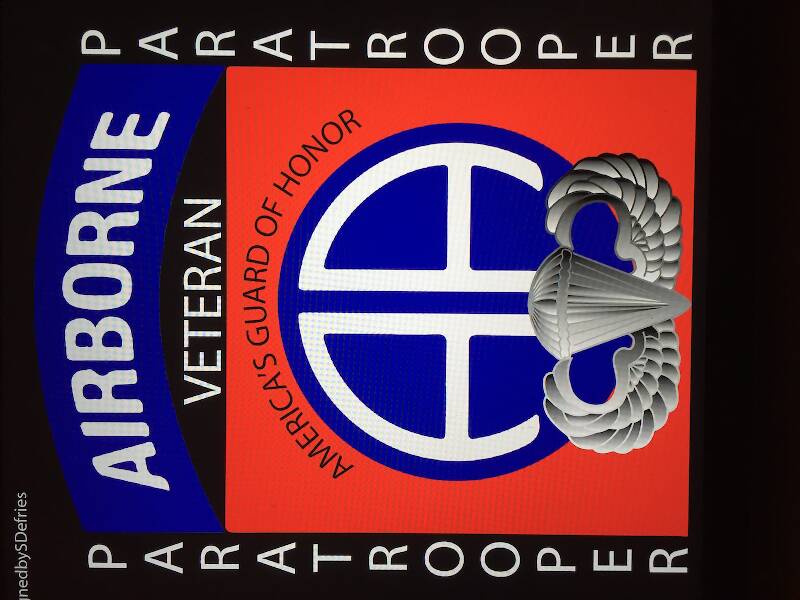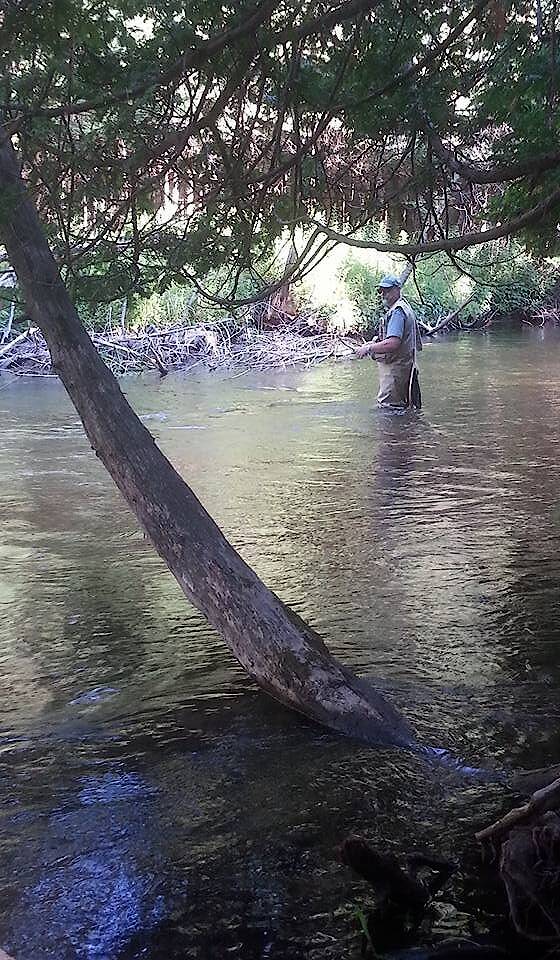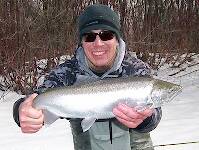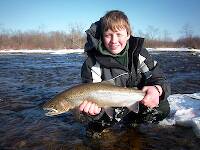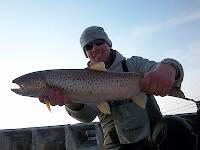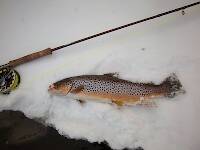
Hex Mayflies
Hexagenia limbata
The famous nocturnal Hex hatch of the Midwest (and a few other lucky locations) stirs to the surface mythically large brown trout that only touch streamers for the rest of the year.
Featured on the forum

This specimen keys pretty easily to Onocosmoecus, and it closely resembles a specimen from Alaska which caddis expert Dave Ruiter recognized as this genus. As with that specimen, the only species in the genus documented in this area is Onocosmoecus unicolor, but Dave suggested for that specimen that there might be multiple not-yet-distinguished species under the unicolor umbrella and it would be best to stick with the genus-level ID. I'm doing the same for this one.

Troutnut is a project started in 2003 by salmonid ecologist Jason "Troutnut" Neuswanger to help anglers and
fly tyers unabashedly embrace the entomological side of the sport. Learn more about Troutnut or
support the project for an enhanced experience here.
David82nd on May 25, 2017May 25th, 2017, 12:46 am EDT
Was wondering how many guys find a pattern" recipe" tie a few then get comfy/w it and then completely change it up, colors materials , sizes ?
When I see a pattern I like or think could work in particular conditions I'll play with it , I may try a different dubbing, or try a different type of Hackle. It definitely makes things fun and keeps the creative interest going in my opinion , plus I guess this how new patterns are created .
There are times this gets the best of me lol, I'll try so many variations of a fly then look at end of night and think " what the heck was I thinking lol
However it's all in fun
When I see a pattern I like or think could work in particular conditions I'll play with it , I may try a different dubbing, or try a different type of Hackle. It definitely makes things fun and keeps the creative interest going in my opinion , plus I guess this how new patterns are created .
There are times this gets the best of me lol, I'll try so many variations of a fly then look at end of night and think " what the heck was I thinking lol
However it's all in fun
Wbranch on May 25, 2017May 25th, 2017, 1:23 am EDT
Hi David,
I'm a pretty boring ho-hum fly tier. I pretty much stick to a recipe and don't often try to "develop" a new fly. I doubt if I have ever tied a fly completely different than flies I have seen in pattern books. While I am not very innovative I do strive to tie very neat and proportioned flies whether they be dries, nymphs, or streamers.
I'm sending you a picture of a couple traditional Maine brook trout streamers I tied a couple of months ago. I had wanted to go fish the Magalloway river in NW Maine but I didn't have a partner and didn't want to bear the cost of the motel and gas by myself. I believe I may have already posted the picture and don't want to have other forum members be saying "I think Matt is getting senile as he just posted this picture."
I'm a pretty boring ho-hum fly tier. I pretty much stick to a recipe and don't often try to "develop" a new fly. I doubt if I have ever tied a fly completely different than flies I have seen in pattern books. While I am not very innovative I do strive to tie very neat and proportioned flies whether they be dries, nymphs, or streamers.
I'm sending you a picture of a couple traditional Maine brook trout streamers I tied a couple of months ago. I had wanted to go fish the Magalloway river in NW Maine but I didn't have a partner and didn't want to bear the cost of the motel and gas by myself. I believe I may have already posted the picture and don't want to have other forum members be saying "I think Matt is getting senile as he just posted this picture."
Catskill fly fisher for fifty-five years.
Jmd123 on May 25, 2017May 25th, 2017, 10:25 am EDT
David, I "created" a fly called the KBF (Killer Bass Fly). Look it up on this site. All I did was take the old steelhead pattern called the Comet and change up the materials and colors. The steelhead version is orange and yellow, the KBF is silver and grey; the steelhead version has bucktail, the KBF uses grizzly marabou; the steelhead version uses flat tinsel, the KBF uses crystal tinsel chenille, etc. I named it after I pulled a 20" 5.5 lb. largemouth out of a pond in Texas with it...and it hasn't stopped catching bass (largemouth and smallmouth), sunfish, perch, crappie, and trout ever since, including several personal bests.
So yeah, I've done a bit of that...
Jonathon
P.S. Matt ties some gorgeous flies, look up some of his posts on here too!
So yeah, I've done a bit of that...
Jonathon
P.S. Matt ties some gorgeous flies, look up some of his posts on here too!
No matter how big the one you just caught is, there's always a bigger one out there somewhere...
David82nd on May 25, 2017May 25th, 2017, 12:07 pm EDT
Jonathon, that's awesome I love doing that I keep notes as well on the things I change , colors ,size, different Hackle , based on results I find when on the rivers ,
Matt does tie a beautiful fly I seen several and his work is very nice, it is a true art , the addiction never stops lol , from buying materials to chasing patterns I'm always at the vice ,
Matt does tie a beautiful fly I seen several and his work is very nice, it is a true art , the addiction never stops lol , from buying materials to chasing patterns I'm always at the vice ,
TimCat on May 27, 2017May 27th, 2017, 11:42 am EDT
I love mixing up and trying out new materials and colors for recipes. Sometimes for the fun of it, and sometimes for necessity (the mother of invention!). It's fun. But this got me thinking about "new" patterns.
I've noticed that there are really only a small number of truly original patterns. For example, search any species of mayfly dry pattern and check out basic components. It will usually be a catskill or comparadun basically with different colors for the materials and the appropriate size. Now, that being said, there are some really innovative (at one point in time at least) patterns. I know that people are thinking up new ideas on a daily basis too. I'm always mixing up colors and materials, but usually using a recipe or format that has already been thought of. It's like using M&Ms or Reese's pieces instead of chocolate chips in your cookies. I would bet that some of these little tweaks can make a world of difference, depending on the various conditions at play in a particular body of water.
I think the only thing I've done while tying that was "outside the box", is wrap some rough grouse feathers in front of my comparadun wings, which is still a comparadun, just with some soft hackle added to the front of the wing. I also would bet that somebody has tried this before. I still haven't had a chance to fish these for trout yet this season (only bluegills, and they eat pretty much anything), but I bet they will do alright with some brookies too :)
Bottom line is: I love tying flies and I love the creativity that can be involved... Now I just need to work on that whole skill part of it. Ha! My 15 minute hare's ears will soon be down to about 10 hopefully.
I've noticed that there are really only a small number of truly original patterns. For example, search any species of mayfly dry pattern and check out basic components. It will usually be a catskill or comparadun basically with different colors for the materials and the appropriate size. Now, that being said, there are some really innovative (at one point in time at least) patterns. I know that people are thinking up new ideas on a daily basis too. I'm always mixing up colors and materials, but usually using a recipe or format that has already been thought of. It's like using M&Ms or Reese's pieces instead of chocolate chips in your cookies. I would bet that some of these little tweaks can make a world of difference, depending on the various conditions at play in a particular body of water.
I think the only thing I've done while tying that was "outside the box", is wrap some rough grouse feathers in front of my comparadun wings, which is still a comparadun, just with some soft hackle added to the front of the wing. I also would bet that somebody has tried this before. I still haven't had a chance to fish these for trout yet this season (only bluegills, and they eat pretty much anything), but I bet they will do alright with some brookies too :)
Bottom line is: I love tying flies and I love the creativity that can be involved... Now I just need to work on that whole skill part of it. Ha! My 15 minute hare's ears will soon be down to about 10 hopefully.
"If I'm not going to catch anything, then I 'd rather not catch anything on flies" - Bob Lawless
Mem19 on May 27, 2017May 27th, 2017, 3:47 pm EDT
Hi I'm new to fly fishing (and this forum ). I was wondering how people remove flys from there lines once you are done fishing and want to take your rods apart. Thanks for the help.
Taxon on May 27, 2017May 27th, 2017, 5:48 pm EDT
Hi Matt. Welcome to this forum. As to what I do when done fishing, and it's time to take my rod apart:
1) clip fly off close to the hook eye
2) put fly away (before I lose the fly)
3) wind line, leader, and tippet on to reel
4) remove reel from rod
5) put away reel
6) disassemble rod
7) put rod sections in rod sock
8) put rod sock in rod case
9) put cap on rod case (before I lose the cap)
1) clip fly off close to the hook eye
2) put fly away (before I lose the fly)
3) wind line, leader, and tippet on to reel
4) remove reel from rod
5) put away reel
6) disassemble rod
7) put rod sections in rod sock
8) put rod sock in rod case
9) put cap on rod case (before I lose the cap)
Mem19 on May 28, 2017May 28th, 2017, 11:57 am EDT
Ok thanks for the help
Roguerat on May 29, 2017May 29th, 2017, 2:32 am EDT
Welcome, Matt!
Roger's routine is spot-on, especially regarding rod storage ASAP after getting the reel off and so on. No need to expose a rod to accidental damage in a closed car door or getting stepped on, etc.
I also strip the line off any recently used reels and run the line through a 'cleaning box' with Glide or Loon dressing on the pads, spooling the line back onto the reel to let it dry for a day or so, then strip it off again to polish the line and have it ready for the next trip. You'd be surprised how dirty the pads in the box get, and how sticky a non-dressed line can be after a while. Floating lines will float higher and dryer with a good cleaning as PM's.
tight (and clean!) lines,
Roguerat
'Less is more...'
Ludwig Mies Vande Rohe
Roger's routine is spot-on, especially regarding rod storage ASAP after getting the reel off and so on. No need to expose a rod to accidental damage in a closed car door or getting stepped on, etc.
I also strip the line off any recently used reels and run the line through a 'cleaning box' with Glide or Loon dressing on the pads, spooling the line back onto the reel to let it dry for a day or so, then strip it off again to polish the line and have it ready for the next trip. You'd be surprised how dirty the pads in the box get, and how sticky a non-dressed line can be after a while. Floating lines will float higher and dryer with a good cleaning as PM's.
tight (and clean!) lines,
Roguerat
'Less is more...'
Ludwig Mies Vande Rohe
Quick Reply
Related Discussions
Topic
Replies
Last Reply


